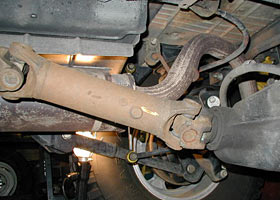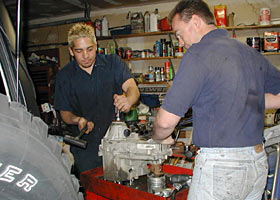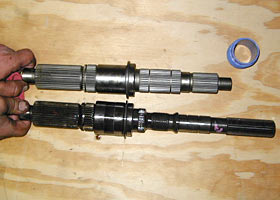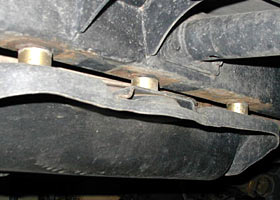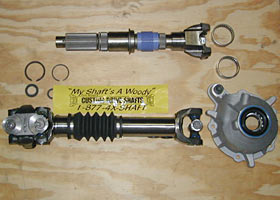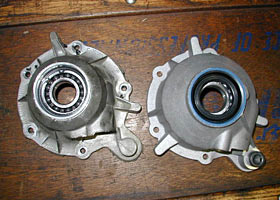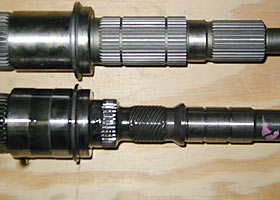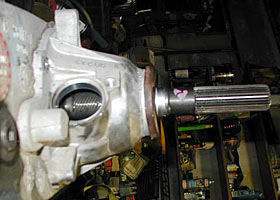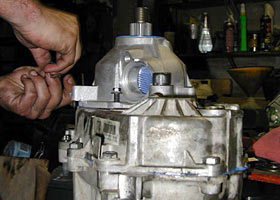If you read the Superlift Rock Runner suspension article you know exactly what I am talking about. Any time you make a modification to your Jeep you open a can of worms. A suspension install can bring about a lot of worms. Two of the biggest worms you will encounter are a change in gear ratio and driveline vibrations. The one we are going to address here is the driveline vibration problem. Since not all of us are mechanics or engineers, I think the first thing we should do is define the problem. Once we have done that we can talk about the solutions and, of course, how JB Conversions and Tom Wood's Custom Drive Shafts helped us solve them. BAD VIBES! When you lift the Jeep to gain ground clearance, you move the tail end of the transfer case up and away from the rear axle. This causes the operating angle to be steeper, which in turn causes a binding effect on the u-joints at the ends of the drive shaft, leading to vibration. The extent of this effect can vary from Jeep to Jeep. Some may only have a small annoying vibe, but even a little vibration can wear out u-joints in a hurry. The effect gets much worse off-road as your suspension flexes even farther away from the transfer case. Broken u-joints, drive shafts and transfer cases could result in short order. Vibration
Robbery The first thing you lose is the comfort and smooth operation of your expensive Jeep. The second thing you loose is reliability on and off-road. The constant vibration and resonance of the driveline shakes bolts and u-joints to pieces. The last thing is horsepower. Yes, horsepower! What do you think actually powers the vibration? The power from the engine makes it through the transmission to the transfer case and then to the rear drive shaft. If all of that power makes it to the rear axle, you feel it as forward motion of the Jeep. If there is something binding in the driveline, that energy is being transferred into a vibration and not forward momentum. The power loss may be minor in most cases but think about how many horsepower it takes to shake your whole Jeep with a vibration. I just installed a K&N air filter in hopes to gain 5-10 hp. What if I am losing the same amount in my driveline due to a poor drive shaft angle?
Worm Farm?
Option A
Drop kits also have several negative effects, though. You lose some of your precious ground clearance you were trying to gain by installing the lift. Your shift levers are now shorter in the cab of the Jeep and may even require floor trimming in some models to make them work right in second, fourth, and reverse. This is more common in YJ's than TJ's. It also causes an extra bind on the motor mounts since the engine is now tilted rearward. Option B
A slip yoke eliminator kit (SYE) uses a C/V (constant velocity) joint, which bolts on to the back of the transfer case. The kits eliminate the slip yoke (thus the name) and use an oil seal to keep the fluids inside. By eliminating the slip yoke design on the back of the transfer case, you benefit in several ways. First, you can shorten the overall length of the transfer case output shaft by 4-6 inches. This translates to 4-6 inches that you can use for a longer drive shaft. This alone makes for a better drive line angle without lowering the transfer case. It also gives you the ability to remove the rear drive shaft should you break it.This means that you CAN limp it back home in front wheel drive. It also means that your shift levers etc. stay where they were designed to be, because in most cases, you can get rid of that transfer case drop kit and tuck the case back up where it belongs. This actually makes the Jeep run and drive like it was designed to do. The SYE kits and drive shafts integrate into a Jeep seamlessly. You will have to keep in mind, though, that the rear pinion angle needs to be adjusted, no matter which method you use. Option B+ The best approach is to buy a kit that includes a whole new shaft to put inside the transfer case. The kit from JB Conversions is exactly that. It is a heavy-duty shaft made to the exact transfer case manufacturer's specifications. This means that not only do I get to put NEW parts in the Jeep, but I have also now increased the strength of my transfer case. The JB Conversions shaft has an 18% larger shaft diameter than the stock NP231 shaft. The shaft also has 32 splines compared to the original 27 splines. That gives the shaft a 54% increase in torque capacity. The JB conversions kit comes with everything you need for the transfer case, including a NEW rear tail housing. The JB Conversions' set up places the output at the shortest possible point without sacrificing the manufacturer's design specifications. That is why it comes with the new tail housing. This makes it the strongest and most reliable SYE kit on the market. I don't want to have any worries about the integrity of my transfer case on or off-road. Doing it right the first time means that I won't have to do it again. And as long as we are upgrading to a heavy duty transfer case, we may as well upgrade to one of Tom Wood's heavy-duty rear drive shafts.
|
|||||||||||
|
Help spread the ROCKCRAWLER world!
Share on Facebook
|

